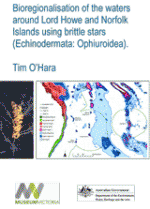Bioregionalisation of the waters around Lord Howe and Norfolk Islands using brittle stars (Echinodermata: Ophiuroidea)
Timothy D O’Hara. 2008.
Download

About the report
Ophiuroid assemblages were successfully predicted from current museum sample data using presence-only modeling techniques and a multivariate classification on the resulting species occurrence probabilities across the Coral and Tasman Seas (20-37°S, 148-172°E).
The classification involves two-stages.
The first uses a non-hierarchical clustering technique to reduce the number of data points (map-pixels) to a manageable number that can be analysed in a second stage with a hierarchical classification method.
For both steps, the Bray-Curtis similarity statistic is used.
The benefits of this model-then-classify approach were:
- It did not rely on consistent sampling techniques. Sample data contributed information to the species distribution patterns regardless of how or when it was collected.
- It did not depend on accurate absence data. Rarely can we have confidence that a species is truly absent from a given area. This is especially true for large-scale studies, where the pixel resolution is on a scale of square kilometers.
- Direct multivariate analysis of species occurrence probabilities was threshold independent (ie an arbitrary threshold did not have to be set to distinguish a ‘presence’ from an ‘absence’).
- A two step classification preserved the benefit of a hierarchical classification (ie an explicit hierarchical breakdown of classes) while analysing very large datasets.
- The Bray-Curtis similarity index is commonly used in ecological studies to reduce the emphasis on joint absences (eg it was not significant if a deep-sea species was absent from both tropical and temperate littoral areas).
The environmental predictors that contributed most to the species models were depth and seafloor temperate, and to a lesser extent nitrate, oxygen and sea-surface temperature. Productivity and surface current velocity were not emphasised.
The resulting maps of ophiuroid assemblages across the study area primarily reflect different depth strata, forming distinct classes at littoral, shelf, upper slope and mid-slope depths and only differentiating into distinct temperate and tropical clusters in shallow water (littoral and shelf depths) along the Australian coastal margin.
The temperate New Zealand fauna only partially extends into the SE corner of the study area.
Lord Howe and Norfolk Islands support distinct complexes of tropical, temperate and endemic species, in part reflecting the influence of the East Australia Current.
There are a few endemic echinoderms known from both islands, although these are relatively uncommon and may eventually be found elsewhere.
The bases of these islands support similar species to habitats with similar depth and environmental profiles elsewhere, including other seamounts in the region and rocky habitats along the continental margins.
Both the Lord Howe Rise and Norfolk Ridges exhibit a north-south transition of species, however, this is less dramatic than for the Australian continental margin.
This is in part due to the lack of shallow water habitat along these ridges. Latitudinal gradients are more prominent in shallow water within the study area.
Seamounts within the study areas rarely did not appear to contain more endemic ophiuroid species than similar areas along the continental margins.
Instead the majority of species on seamounts appear similar to those occurring elsewhere at similar depths and seafloor temperatures.
This suggests that species disperse to these seamounts from surrounding habitat regularly enough to prevent allopatric speciation.
These conclusions need to be confirmed by genetic data as cryptic speciation is common in echinoderms.
However, it is likely that seamounts have accumulated distinct assemblages of species over time depending on their location, form, depth and age.
Seamounts do not show the consistency and specialisation of seafloor assemblages to be considered a single unit for management purposes such as marine-park planning.
Until we understand more about the ecological and historical factors that structure seafloor assemblages, ‘seamounts’ should be evaluated independently to ascertain their conservation status.
This study emphasises the tropical affinities of many ophiuroid species that live across the Tasman and Coral Seas.
This differs from a preliminary pattern for fish described from the NORFANZ expedition in 2003 which emphasised:
- the southern affinities of many fish species
- possible areas of endemism on the Middlesex Bank, Lord Howe Island, Norfolk Island, Norfolk Ridge, Wanganella Bank and Reinga Ridge.
However, both ophiuroids and fish were primarily structured by depth.
Learn about your marine parks
Stay in touch
Subscribe to receive important updates about your marine parks. Enter your email address and click "join now".







